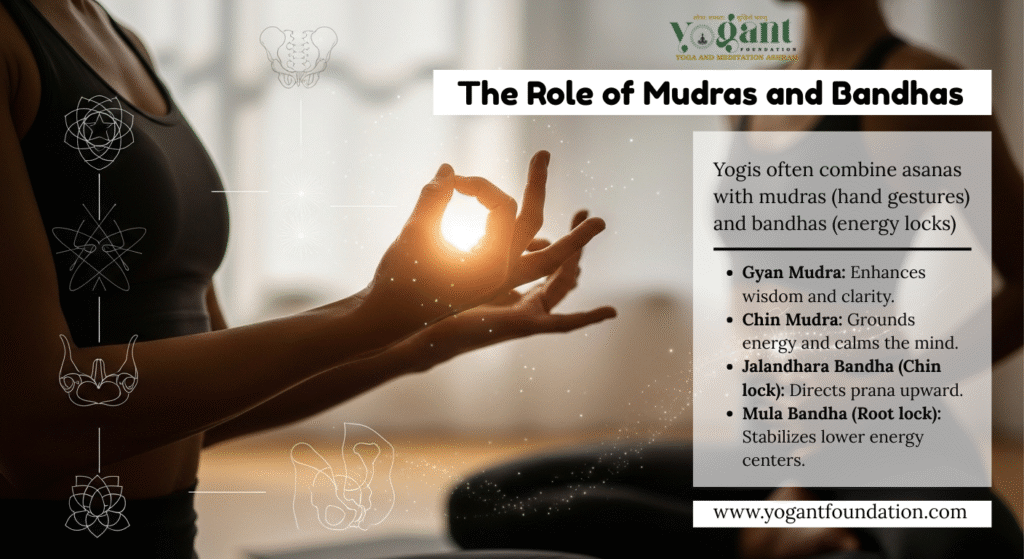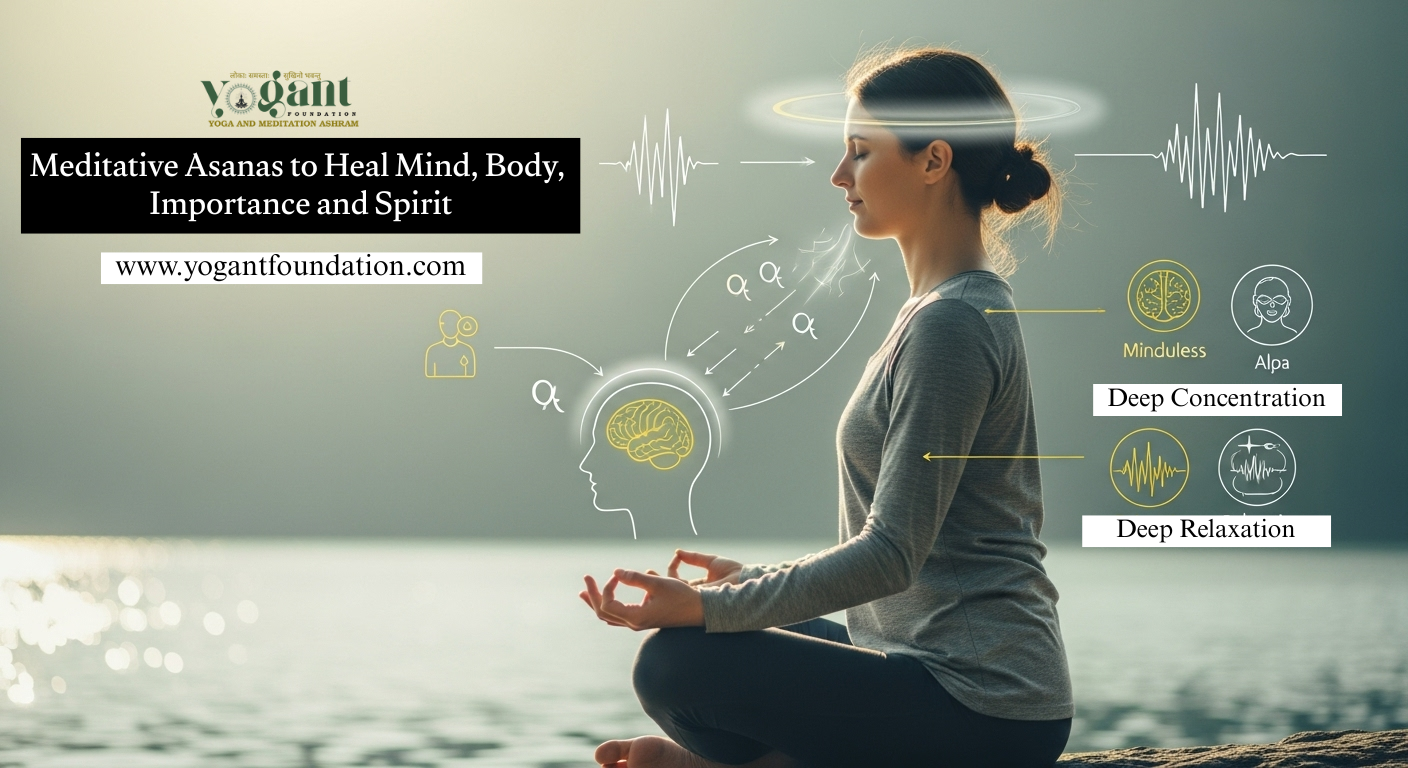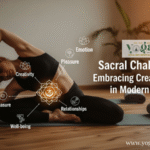Today’s world is noisy, and stillness has become an art. Silence can be a luxury. The ancient practice of yoga can help us connect with ourselves. The posture isn’t just for flexibility or strength. It’s the gateway to inner tranquility. These meditative asanas can harmonize both your brain and body, and they may awaken heightened awareness. No matter if you’re a beginner or an expert, you can still transform your body and mind with meditative Yoga Asanas.
What Are Meditative Asanas?
Sanskrit asana refers to a “stable and comfortable posture,” specific yoga poses, specifically designed for extended sitting and meditation. Asanas’ main purpose is to promote comfort, energy flow, and stability to enable the practitioner to sit still for a long time without distraction.
As you practice these poses, your body will be aligned, your hips and energy centres will be balanced, and your chakras will have a better balance. You can also prepare yourself for deeper meditation and the pranayama.
The Benefits of Meditative Yoga Asanas
The meditational asanas connect the mind and body. Restlessness and pain are no longer issues when in a relaxed and comfortable posture. As the body becomes quieter, the mind also does.
The Purpose of Meditative Asanas:
- While meditating or doing pranayama, your posture must remain steady.
- Reduce physical stress, which can cause restlessness and mental distraction.
- You can align your spine in order to let the energy (prana) ascend.
- To activate the higher-level awareness and stimulate the nervous system.
- Balance chakras (especially root, sacral, and crown centers)
The asana is right when it feels effortless, like you can sit in the pose for an endless amount of time without feeling distracted or uncomfortable.
7 Meditative Asanas & Types of Meditative Asanas
Traditional asanas are categorized under meditative poses. Asanas are suited to each person based on flexibility and comfort.
Check out the main ones.
1. Sukhasana (Easy Pose)
Sukhasana, or the simple yet relaxing position of sitting down, can be described. The word Sukha is a literal translation of “ease”, or “happiness.”
How to Practice:
- Cross-legged seated with spine up.
- When performing Gyan Mudra, keep both hands flat on the knees.
- Close your eyes and relax your shoulders.
- Breathe deeply and relax your entire body.
Benefits:
- Calms the body and mind
- Relaxation and relief from anxiety
- Improves concentration during meditation.
- Perfect for those who are new to the game or have limited flexibility.
Spiritual Note: Sukhasana signifies simplicity within – it is a constant reminder that inner peace does not need complicated things.
2. Padmasana (Lotus Pose)
Padmasana holds a significant symbolic value in the yogic tradition. This is the Lotus Pose of consciousness growing over the muddy water.
How to Practice:
- Seated with the legs stretched out, extend your legs.
- Your left leg should be on top of the right knee.
- Then, put your right foot on top of the left thigh.
- Chin Mudra: Keep your hands straight in Chin Mudra.
Benefits:
- Spine receives additional energy.
- The stillness of the body and its stability are increased.
- The Sahasrara and Muladhara.
- With this product, you can control your breath and meditate more deeply.
Note: Padmasana is a full-length version of the half lotus pose (Sukhasana).
3. Siddhasana (Accomplished Pose)
Siddhasana is referred to as the “Pose of Adepts” in many ancient texts, including Hatha Yoga Pradipika.
How to Practice:
- Seated with the legs stretched out, extend your legs.
- The heel of the bent leg should be placed on the perineum.
- It is best to place the heel at the pubic bone, just beneath the first leg.
- The spine must be straight, and the chin should be slightly tucked in ( Jalandhara Bandha).
Benefits:
- Both the nervous system and endocrine systems are in balance.
- Promotes physical and mental stability
- The tool is powerful and helps control sexual energy.
- Meditation regularity will find this product ideal.
Spiritual Meaning: Siddhasana means mastery of body and senses, the “accomplished status” of a yogi.
4. Swastikasana (Auspicious Pose)
This name derives from Swastik (“auspicious”)
How to Practice:
- Sitting on the ground, cross both legs. Tuck one foot into the thigh and the other under.
- Kneel and place hands in Jnana Mudra.
- Straighten your spine and relax the shoulders.
Benefits:
- Energy is stabilized in the body.
- The goal is to promote mental equilibrium and peace.
- It is designed for both novices and experienced practitioners.
Symbolism: The symbol represents harmony between feminine energy and masculine power.
5. Vajrasana (Thunderbolt Pose)
Vajrasana varies from other postures because it is done on the heels. It is best performed after meals, as it aids digestion.
How to Practice:
- Kneel with your legs together.
- Sit back on your heels, keeping your spine erect.
- Relaxed shoulders and palms placed on legs.
- Just close your eyes and take a deep breath.
Benefits:
- Aids in digestion and reduces acidity.
- It improves posture and increases blood circulation.
- Meditation improves focus and groundedness.
Spiritual Meaning: Vajra in Tibetan means “thunderbolt”. The word represents inner resiliency and strength. Qualities that are essential for every meditation.
6. Ardha Padmasana (Half Lotus Pose)
Arha Padmasana can help those with tight hips.
How to Practice:
- Sit cross-legged.
- One foot should be placed under the knee on the other leg, while the second one is placed oppositely.
- Keep spine tall, gaze soft.
Benefits:
- The Lotus is ready for a full body.
- It is important to maintain the energy balance.
- The mantra can also be used for meditation or pranayama.
7. Bhadrasana (Gracious Pose)
Bhadrasana has also been called Butterfly Pose. The pose prepares your body for long-term meditation by opening up your hips.
How to Practice:
- While you are sitting, put the soles of your feet together.
- Both feet should be together.
- Maintain a relaxed posture and keep your shoulders straight.
- Concentrate on your breathing by closing your eyes.
Benefits:
- It is more flexible in the inner thighs.
- Calms anxiety and tension.
- Increases in energy flow to the pelvic area.
The Science Behind Meditative Asanas
Yoga philosophy can be described as a science. Modern studies confirm that positions of sitting with relaxed muscles and a spine aligned can be beneficial.
- Reduce cortisol, the stress hormone.
- Activate to activate the parasympathetic nervous system.
- Improved focus, memory, and emotion regulation.
- Enhance blood circulation in the head.
- Encourage them to deepen their breathing.
Keeping calm also promotes the production of endorphins. The result is a naturally high.
Connection Between Meditative Asanas and Chakras
Some of the Asanas designed to influence specific energy centers (chakras) on the human body are:
| Asana | Chakras Active | Energy Effect |
| Sukhasana | Root & Sacral | Grounding and Creativity |
| Padmasana | Crown | Spiritual awakening |
| Siddhasana | Root and Crown | This balance and transformation of energy |
| Vajrasana | Solar Plexus | Energy and digestion |
| Swastikasana | Heart | Calm and emotional stability |
| Bhadrasana | Sacral | Energy for Creative and Reproductive Activity |
Practicing mindfully can lead to subtle changes, such as a shift from restlessness and tension towards calmness and growth.
Breath and Awareness in Meditative Asanas
Being aware of your breath will help you to practice meditative asanas. After the body is stable, it’s time to:
Natural Breath – Observation with No Control
You can now slowly move into yoga, deep breathing.
Your breath should gradually be more subdued. Almost as though you were yourself breathing.
It is in this state that meditation truly begins.
Preparing the Body for Meditative Asanas
Don’t worry if it feels uncomfortable to sit. For many people, gentle preparation is required.
Take a moment to consider the following suggestions:
- You can stretch the hips with Butterfly Poses, Pigeon Poses, and Hip Stretching.
- Remove the spine using Cat-Cow Movement
- Rotate your shoulders in a gentle way to help them relax.
- Deep breath for two to three minutes helps you calm your energies.
After regular practice, the body adjusts to sitting still.
Common Challenges and How to Overcome Them
1. Uncomfortable or Numbness
Under your hips, you can place a blanket that has been folded or a pillow. If you want to be comfortable, make sure your hips are lower than your knees.
2. Restless Mind
You can use a mantra to focus your attention, or you can concentrate on your breathing. Patience is the key to achieving stillness.
3. Sleepiness
You can exercise in the morning or at dusk when you have a natural energy balance.
4. Impatience
Enjoy the moment. Every minute of silence will help your nervous system to find peace.
Meditative Asanas for Daily Practice (15-Minute Routine)
- In Sukhasana, you can start by breathing deeply for 2 minutes.
- After 3 minutes, observe you’re breathing and shift into Vajrasana.
- Close your eyes, focus on the inside, and move into Siddhasana.
- End with folded hands in prayer along with a small bow toward your awareness.
It is possible to achieve remarkable results with a daily routine.
Meaning and Spiritual Importance of Meditative Asanas
In ancient times, yogis used to refer to postures of meditation, like the seat of enlightenment, as seats for enlightenment. One can see the Atman (the real Self) when one’s body is at rest.
As the still body moves inside, the spiritual energy Kundalini Shiksha awakens.
Asanas can become much more than simple postures when they are consistently practiced. These portals become sacred doors leading to self-realization.

The Role of Mudras and Bandhas
To achieve deeper meditations, many yogis will combine the asanas with bandhas.
- Gyan Mudra: Enhances wisdom and clarity.
- Chin Mudra: Grounds energy and calms the mind.
- Jalandhara Bandha (Chin lock): Directs prana upward.
- Mula Bandha (Root lock): Stabilizes lower energy centers.
You can improve concentration by combining these two exercises.
Modern Relevance of Meditative Asanas
Asanas for meditation are the best way to restore our natural rhythm. It is important to stop, breathe, and listen. Peace isn’t in having more but less.
Even 10 minutes per day of Sukhasana can benefit:
- Reduce Anxiety
- Enhance your emotional balance
- Enhance sleep quality.
- Increase your awareness of yourself.
It is a timeless solution that can used for any circumstance.
Integrating Meditative Asanas into Life
- Morning routine: Begin your day in silence and calmness by breathing.
- Work Break: Sukhasana for 5 minutes between tasks.
- A reflection for the evening: Thankfulness at the conclusion of a Vajrasana Day.
- Weekly Deep Practice: Dedicate one hour each week to breathing, meditation, and stillness.
Consistency transforms occasional tranquility into calm.
Conclusion: The Posture of Peace
They are not static positions. They are active expressions of stillness. Our souls whisper when we are balanced. When we are in balance, our minds and hearts begin to soften. The great sage Patanjali described yoga as “chittaviritti nirodhah”, which is the cessation and fluctuation in the mind.
The foundation of this journey is the Asanas:
It can be found by being still.
It is possible to close your eyelids.
Find peace by following your breath.
Read Blog: 6 Yoga Asanas to High Blood Pressure


